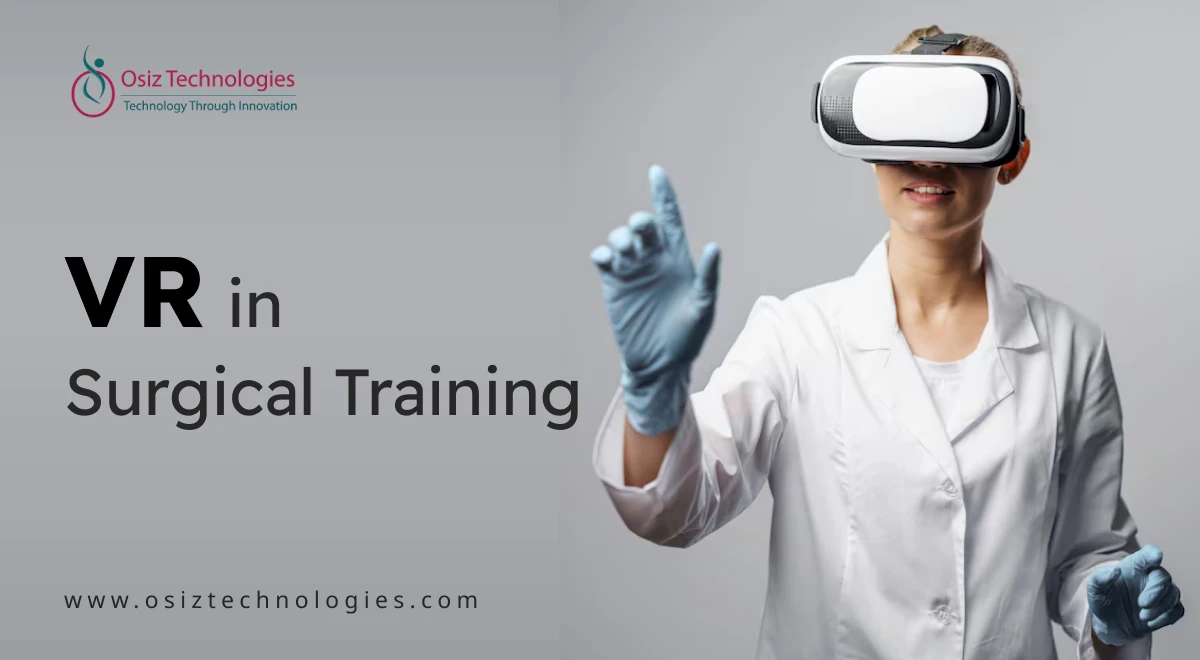Virtual reality (VR), a cutting-edge tool in the rapidly developed field of medical technology, revolutionizes surgical training. Surgical education has given a strong emphasis on historical experience, which frequently requires significant time commitments and access to real patients. On the other hand, virtual reality changes this strategy by offering a safe, regulated, and attractive environment to surgeons where they can develop, refine, and master their skills. In addition to improving surgical accuracy, this innovation speeds up skill development by providing instant feedback and the capacity to repeatedly execute intricate procedures without running the danger of damage. We will examine how virtual reality (VR) is changing surgical training in this blog, with an emphasis on how technology affects precision, learning efficacy, and the direction of healthcare education.
VR for Surgical Training
Virtual reality brings revolution to surgical training by offering a realistic, interactive platform where medical professionals can practice complex processes. Surgeons can refine their skills, improve accuracy, and meet rare or high-risk landscapes without the need for real patients. This engrossing technology accelerates learning and skill development while providing quick responses to promote self-confidence. Companies such as Osiz are ahead of this innovation, especially and offer state-of-the-art VR solutions designed for surgical education. By integrating virtual reality, Osiz helps to bridge the theoretical knowledge and experience on his hands.
How Virtual Reality Improves Surgical Skills
Virtual Reality (VR) has emerged as a groundbreaking surgical education technique, providing an innovative and attractive way of improving surgical skills. By Emulating the conditions in the real world, our surgeon allows you to gain experience on the hands in a safe environment. This strategy relieves the stress of working with living patients by repeatedly allowing practice, skill development, and coping with complex operations.
How It Works:
Immersive Simulations: VR creates realistic surgical environments, enabling surgeons to practice various procedures—from routine surgeries to rare, high-risk ones—without the need for live patients or cadavers.
Repetition and Practice: Surgeons can repeat surgeries as often as needed, helping to build muscle memory, improve precision, and enhance hand-eye coordination in a low-stress setting.
Instant Feedback and Performance Tracking: VR systems offer real-time feedback, tracking key metrics such as speed, accuracy, and technique. Surgeons can identify areas of improvement and monitor their progress over time.
Focused Skill Development: VR allows for focused practice on specific surgical steps, such as suturing, incision, or dissection, enabling tailored learning and faster mastery of complex techniques.
Risk-Free Environment: Since there are no real-world consequences, trainees can make mistakes and learn from them, which accelerates the learning process and enhances confidence.
Essential Features of Our VR for Surgical Training
Our VR surgical training platform is designed to provide a realistic and engrossing experience for surgeons at all skill levels. It offers a wide range of medical scenarios with lifestyle, including laparoscopic surgery, open surgery, and robotic surgery. In addition, the platform provides different tools and instruments to increase the training experience, such as scalpels, forceps, and detractors.
Key features of our VR for surgical training platform include:
-
Realistic surgical scenarios: Our platform features a variety of realistic surgical scenarios, including laparoscopic surgery, open surgery, and robotic surgery.
-
Variety of tools and instruments: We offer a variety of tools and instruments, including scalpels, forceps, and detractors.
-
Haptic feedback: Our platform provides haptic feedback, which allows surgeons to feel the resistance of tissue and organs.
-
Scoring and feedback: Our platform provides scoring and feedback, which allows surgeons to track their progress and identify areas for improvement.
-
Customization: Our platform can be customized to meet the specific needs of individual surgeons and training programs.
Applications of VR Across Different Surgical Specialties
In addition to changing surgical education, Virtual Reality (VR) affects many surgical specialties. By offering challenging procedures and learning experiences on hands, Virtual Reality technology aims to meet unique requirements for many surgical specialties. In many surgical specialties, virtual reality becomes a valuable tool to improve procedural knowledge and accuracy.
Neurosurgery
Virtual Reality technology plays an important role in neurosurgical planning. It provides a surgeon with an engrossing environment to navigate the brain and spinal cord, enabling preoperative preparation carefully for delicate processes. This virtual upper is invaluable for complex surgery such as the removal of tumors, repair of aneurysms, and deep brain stimulation, allowing surgeons to adapt their approach before entering the operating room and ensuring more patient safety.
Orthopedic Surgery
VR provides a spectacular platform, including joint replacement, fracture, and bone adjustment for the simulation of orthopedic surgery. In a safe, regulated virtual setting, surgeons can improve their abilities in processes such as joint replacement and back surgery.
Cardiothoracic Surgery
Cardiothoracic surgeons use virtual reality (VR) to practice complex heart surgery such as minimal invasive procedures, valve repairs and pounding of coronary arteries (CABG). Surgeons achieve accuracy in handling delicate blood arteries and master complex instruments.
General Surgery
General surgery includes a wide range of operations in VR applications, including simple laparoscopic surgery to larger abdominal surgery. Surgeons can practice large techniques such as Saturn, Cut, and Resolution, which will help them gain confidence and ability in ordinary and emergency processes.
Ophthalmology
In ophthalmology, virtual reality technology is handy, as it allows surgeons to model processes such as corneal transplant, retinal operation, and removal of cataracts. Through these simulations, ophthalmologists can improve their microscopic-serial techniques, where accuracy and stability are important to succeed.
Future of VR in Surgical Education and Training
With its increased realism and immersive experiences, Virtual Reality (VR) in surgical education is ready to bring revolution to medical education. More realistic simulations for skill development will be produced by developing haptic feedback and 3D visualization. AI will provide personal training that is customized based on each surgeon's needs and progress. Surgeons from all over the world will be able to communicate and study in real-time through distance education and collaboration. Integration training will also get better in mixed reality (MR) and augmented reality (AR) by providing real-time data during real surgery. VR will be a basic component of surgical education as it becomes more accessible and increases surgical results and patient safety.
Wrapping Up
Surgical education is changing by providing a safe, engaging environment for the development of VR skills. It simulates the conditions of real life, provides immediate response, and enables repeated practice to improve accuracy and speed up learning. Since VR technology is advanced, it will play an important role in individual and distance teaching. Osiz, a leading VR development company, provides tailor-made VR solutions to bridge the standard and hands-on their hands. VR will continue to change the future of surgery, and increase both exercise and patient results.
Listen To The Article
Recent Blogs

Financial Year-End
Offer












